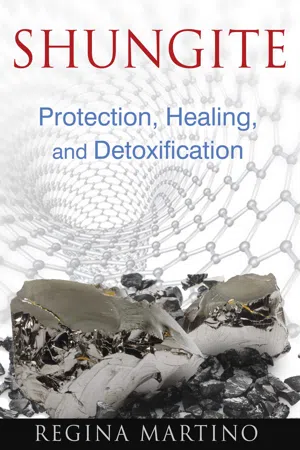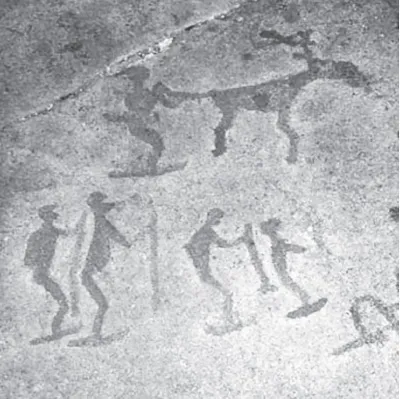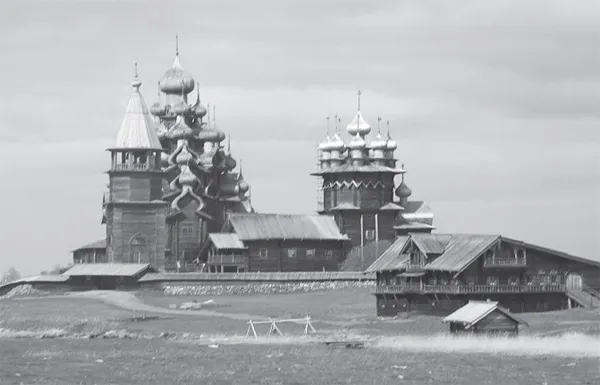![]()
1
WHAT IS SHUNGITE?
In order to start on the right foot, I must add a couple of lines on the pronunciation of the word shungite.
The name is derived from the name of the Karelian village of Shun’ga, where the mineral was first discovered. Shungite is pronounced to rhyme with kite.
THE DIFFERENT TYPES OF SHUNGITE
It’s important to keep in mind that shungite in its natural state contains varying amounts of organic carbon. For this reason you will find stones being marketed under the name shungite that have different appearances. The explanation is very simple: they contain differing quantities of carbon. Following are the three qualities of shungite that are usually found.
Type I Shungite (Silver Shungite)
Type I occurs as a black, vitreous mineral with a semimetallic, silvery shine. It contains 98 percent organic carbon. This is the most scarce form since it accounts for only 1 percent of all shungite that is found. It occurs in very narrow veins having a maximum width of 40 cm (16 inches). It can be easily identified because of its conchoidal fractures. Ocre-colored inclusions are jarosite, a basic sulfate of iron formed from the oxidation of pyrite (see color insert, plates 2–4, for photos of type 1 shungite). Sometimes, in marketing it, this type of shungite is called crystalized because of its naturally faceted appearance but this term is incorrect since shungite is an amorphous mineral and never crystalizes into any shape.
Composition
Carbon = 98%
Nitrogen, Oxygen = 0.9%
Hydrogen = 0.3%
Ash content up to 0.8%
Type II Shungite (Black Shungite)
Type II occurs as a black mineral. This is the kind of shungite most often used to make objects because, unlike type I, it can be easily shaped and polished (giving it a brilliant shine). (See plate 5 in color insert.) It contains 50 percent to 70 percent organic carbon.
Composition
Carbon = 64%
Nitrogen, Oxygen = 3.5%
Hydrogen = 6.7%
Ash content up to 3.3%
Type III Shungite (Gray Shungite)
This occurs as a gray-colored mineral and contains 30 percent to 50 percent organic carbon.
Composition
Carbon = 30%
Silicon dioxide = 56%
Water = 4.2%
Aluminum oxide = 4%
Iron oxide = 2.5%
Potassium peroxide = 1.5%
Magnesium oxide = 1.2%
Sulfur = 1.2%
Calcium oxide = 0.3%
Sodium oxide = 0.2%
Titanium dioxide = 0.2%
There are stones containing a lower percentage of organic carbon. These are termed shungite rock instead of shungite.
DEFINING SHUNGITE
If we were to provide a mineralogical definition for the purest type of shungite (type I), we could say that shungite is a 98 percent carbon, noncrystalline, nongraphite, structurally heterogeneous, vitreous, black mineral with a semimetallic shine.
The mineral is identified as shungite in Walter Schumann’s Gemstones of the World (a definitive reference work in the field of gemology).
![]()
2
SHUNGITE IN HISTORY
Even though the marketing of shungite in Western Europe is gaining momentum, we shouldn’t hail it as a magic and auspicious discovery capable of saving all beings on the planet. It seems more accurate to me to turn directly to the history of Russia, acknowledging that Western countries are not necessarily acquainted with the uses of shungite that have been known and recognized in Karelia for centuries. The fact that fullerenes*1 were discovered and named based on experiments in space laboratories should not be taken as some kind of reappropriation by the West. The Karelians have used fullerenes for centuries without knowing what they were.
After all, for countless generations our ancestors have used the healing properties of herbs, springs, and stones without having any scientific concept of pharmacology, biochemistry, or atomic and molecular structure. Many intuitive discoveries of the past, even the remote past, have made possible enormous progress in present-day scientific medicine.
This mineral, formed billions of years ago, has been known for thousands of years by local people in the region of Lake Onega (the Russian part of Karelia). Archeological research has uncovered numerous very ancient human settlements in this area.
As people followed the retreat of the glaciers in the last ice age (around 9,000 BCE), nomadic tribes of hunter-gatherers gradually settled in Karelia. These people left behind petroglyphs and rock paintings dating back four thousand to nine thousand years and containing images that very often remain mysterious. The rock carvings at Lake Onega, dating from the Neolithic era, notably portray mythological scenes directly related to nature, the seasons, and the elements. Certain themes evoke aquatic birds (their interpretation remains uncertain), mythological creator gods, the progression of seasonal change, migratory patterns, and the transmigration of souls. The Heavenly Elk, the Elk Man, and the Great Mother are also to be found among these petroglyphs. The carvings are found mainly on the eastern shore of the lake which has the richest sites of Finno-Ugrian rock carving.
Petroglyphs of Karelia
Several archeological digs around the lake have brought to light dwellings and sacred sites (labyrinths, sacred stones, burial sites) dating to about 6,000 BCE. Lake Onega is sacred to the Sami shamans. It’s a place of power where the very pure waters are a silent witness to their private ceremonies.
Much later, beginning in the fourteenth century, numerous orthodox churches and convents were built in this area, notably the famous Kizhi Pogost, the parish precinct on the island of Kizhi (fourteenth century) that contains the Church of the Transfiguration (1714), which was built without a single nail or any metallic element. This church has been designated a UNESCO World Heritage site.
Similar to what took place in Western Europe, these Russian churches were not erected in this location haphazardly. In addition to the fact that they lie on trade routes and on sites of great beauty, they draw benefit from the sacred sites that the ancients had chosen for their energetic properties.
Russian chronicles of the seventeenth and eighteenth centuries bear witness that shungite had already been in use for healing at that time. The first official written mention of the healing powers of shungite takes us back to the reign of Ivan the Terrible and his son Feodor I, which saw the end of the Rurikid dynasty. Shungite was not known then by its current name. This black rock was considered to be a local “slate” and was particularly famous for the very pure spring water that sprang forth from it.
The famous Kizhi Pogost on Kizhi island on Lake Onega in the Republic of Karelia, Russia
Boris Godunov (regent and brother-in-law of Feodor I) had himself elected tsar in 1598 and, in order to avoid having his legitimacy to the throne challenged (because he was only an elected tsar), he tried to distance himself from the Romanov family’s influence. He sent the only remaining Rurikid still alive, Feodor Nikitich Romanov, his wife Xenia Romanova, and their young son Mikhail into exile, forcing them to adopt monastic vows. Feodor Romanov was sent to Poland where he adopted the monastic name of Filaret. Xenia Romanova became a nun, assuming the name Martha, and sequestered in a hermitage at Tolvuya, to the north of Lake Onega, where she hovered near death, depleted by privations and the cold. Upon the death of Boris Godunov (in 1605), his oppressive regime loosened its grip and the local peasants, taking pity on her, saved her and cared for her with water from a spring that had miraculous properties (the shungite spring). Once she recovered her health, Martha/Xenia was reunited with her son Mikhail from whom she had been separated for many years. This took place before he returned to Moscow to put an end to eight years of political turmoil and to have himself elected tsar in 1613, taking the place of the usurpers who had preceded him.
Mikhail (Michael I) became the first tsar of the Romanov dynasty, which was to reign for three hundred years until the revolution of February 1917. This anecdote about shungite has come down to us because the death of Xenia/Martha would have brought about significant changes in Russia’s history. To commemorate the recovery of this noble lady, the spring was named the Spring of the Princess. The spring was quickly forgotten in Moscow, however, and the miraculous water returned to anonymity as a source of help and healing, benefiting only the inhabitants of the neighboring villages.
Not until the reign of Peter the Great of Russia does shungite reappear in the annals of history.
In 1714, in a factory established by the tsar for the production of copper near Lake Onega, legend has it that workers who were poisoned or fell seriously ill because of the ore they were processing could be healed in three days with the “living water” from a nearby spring. Peter I ordered an investigation of the spring, which flowed out from a shungite deposit. These investigations clearly showed the extraordinary properties of...


